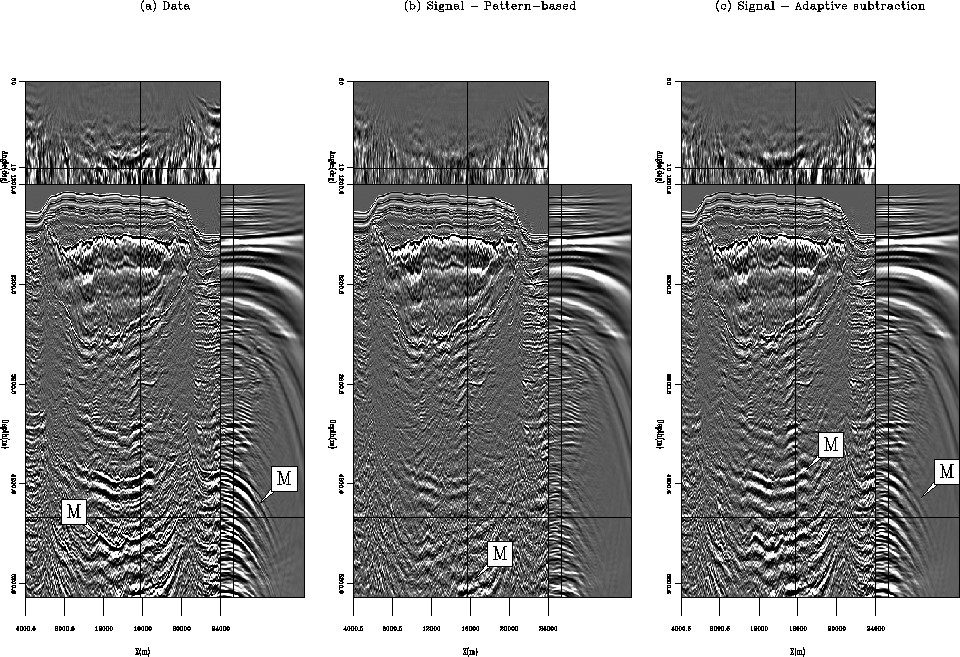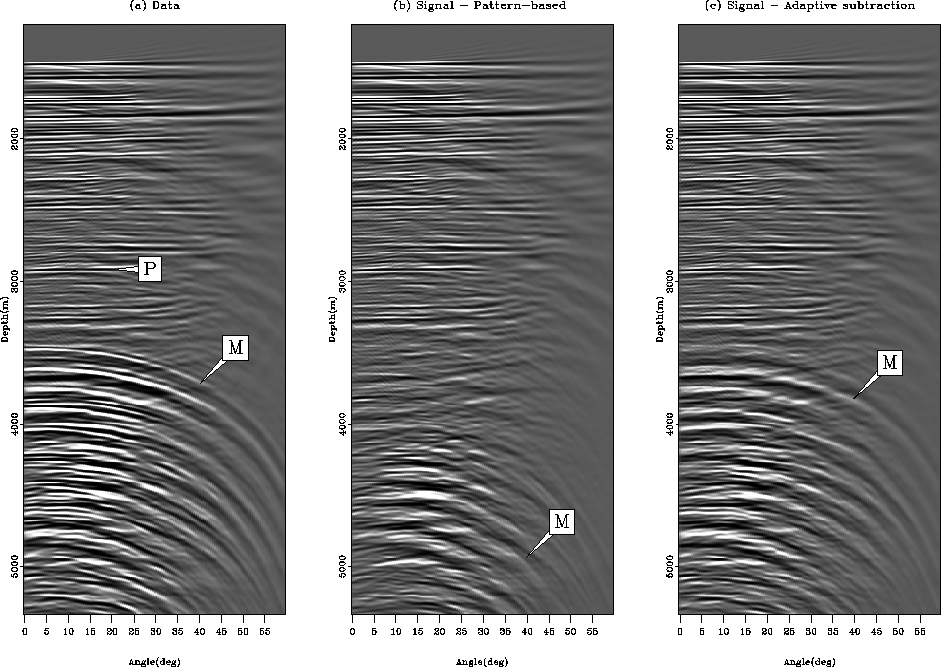




Next: Conclusion
Up: Gulf of Mexico example
Previous: Gulf of Mexico example
In addition to the pattern-based approach, the multiples are
attenuated with adaptive subtraction. Instead of comparing both
results in the data space, the two techniques are now analyzed in
the image space after migration. A split-step DSR migration is used
with three reference velocities. The results of the migrations are
then studied in the angle domain on common-image gathers (ADCIG).
These angle gathers are generated with the method of Sava and Fomel (2003)
after migration Stolt and Weglein (1985); Weglein and Stolt (1999).
Angle gathers can be useful for AVO analysis
Kuhl and Sacchi (2003); Prucha et al. (1999) and can form a convenient basis
for multiple attenuation as well
Alvarez et al. (2004); Sava and Guitton (2005).
Figure ![[*]](http://sepwww.stanford.edu/latex2html/cross_ref_motif.gif) shows the migration results in
the angle domain for the input data (Figure
shows the migration results in
the angle domain for the input data (Figure ![[*]](http://sepwww.stanford.edu/latex2html/cross_ref_motif.gif) a),
the estimated signal with the pattern-based approach
(Figure
a),
the estimated signal with the pattern-based approach
(Figure ![[*]](http://sepwww.stanford.edu/latex2html/cross_ref_motif.gif) b) and the estimated signal with adaptive
subtraction (Figure
b) and the estimated signal with adaptive
subtraction (Figure ![[*]](http://sepwww.stanford.edu/latex2html/cross_ref_motif.gif) c). By looking at the constant
angle section (X=11000 m), it appears that more multiples have been removed with
the pattern-based approach, especially below the salt where the
multiples are the strongest. The common angle gathers corroborate
this: a lot more energy from the multiples is present with
the adaptive subtraction. Note that some multiple energy remains in
both Figure
c). By looking at the constant
angle section (X=11000 m), it appears that more multiples have been removed with
the pattern-based approach, especially below the salt where the
multiples are the strongest. The common angle gathers corroborate
this: a lot more energy from the multiples is present with
the adaptive subtraction. Note that some multiple energy remains in
both Figure ![[*]](http://sepwww.stanford.edu/latex2html/cross_ref_motif.gif) b and Figure
b and Figure ![[*]](http://sepwww.stanford.edu/latex2html/cross_ref_motif.gif) c where
the salt body is present. These multiples have strong curvature and
low-frequency content. These events are probably internal multiples
bouncing between the sea bottom and the top of salt. Another
pass of multiple attenuation in the image space Sava and Guitton (2005)
could eliminate these reflections.
c where
the salt body is present. These multiples have strong curvature and
low-frequency content. These events are probably internal multiples
bouncing between the sea bottom and the top of salt. Another
pass of multiple attenuation in the image space Sava and Guitton (2005)
could eliminate these reflections.
cube.mig
Figure 23 comparison of migrated
sections in the angle domain for (a) the input data with multiples,
(b) the estimated primaries from the pattern-based approach, and (c)
the estimated primaries with adaptive subtraction. Arrows M point to
multiples.





Finally, Figure ![[*]](http://sepwww.stanford.edu/latex2html/cross_ref_motif.gif) shows a comparison of ADCIGs for the
input data with multiples (Figure
shows a comparison of ADCIGs for the
input data with multiples (Figure ![[*]](http://sepwww.stanford.edu/latex2html/cross_ref_motif.gif) a), the estimated
primaries with the pattern-based approach (Figure
a), the estimated
primaries with the pattern-based approach (Figure ![[*]](http://sepwww.stanford.edu/latex2html/cross_ref_motif.gif) b) and
the estimated primaries with adaptive subtraction (Figure
b) and
the estimated primaries with adaptive subtraction (Figure
![[*]](http://sepwww.stanford.edu/latex2html/cross_ref_motif.gif) c) outside the salt boundaries (X=4000 m). It illustrates
once again that the pattern-based approach outperform the adaptive
subtraction method with a cleaner panel.
c) outside the salt boundaries (X=4000 m). It illustrates
once again that the pattern-based approach outperform the adaptive
subtraction method with a cleaner panel.
sedi.mig
Figure 24 Angle domain common image gathers of
the Gulf of Mexico dataset for (a) the input data, (b) the estimated
primaries with the pattern-based approach and, (c) the estimated
primaries with adaptive subtraction. This gather position is X=4000 m,
outside the salt boundaries. Primaries are flat (shown as P) and
multiples are curved (shown as M).





The Gulf of Mexico example demonstrates that the pattern-based approach
is an effective tool for multiple attenuation in complex geology.
Although the multiple model obtained with SRMP presented some obvious
flaws (short offset amplitudes), the proposed approach is able to
attenuate the multiples while preserving the primaries. In addition,
comparisons in the image space after migration on ADCIGs show that
the pattern-based approach gives cleaner panels than adaptive subtraction.





Next: Conclusion
Up: Gulf of Mexico example
Previous: Gulf of Mexico example
Stanford Exploration Project
5/5/2005
![[*]](http://sepwww.stanford.edu/latex2html/cross_ref_motif.gif) shows the migration results in
the angle domain for the input data (Figure
shows the migration results in
the angle domain for the input data (Figure ![[*]](http://sepwww.stanford.edu/latex2html/cross_ref_motif.gif) a),
the estimated signal with the pattern-based approach
(Figure
a),
the estimated signal with the pattern-based approach
(Figure ![[*]](http://sepwww.stanford.edu/latex2html/cross_ref_motif.gif) b) and the estimated signal with adaptive
subtraction (Figure
b) and the estimated signal with adaptive
subtraction (Figure ![[*]](http://sepwww.stanford.edu/latex2html/cross_ref_motif.gif) c). By looking at the constant
angle section (X=11000 m), it appears that more multiples have been removed with
the pattern-based approach, especially below the salt where the
multiples are the strongest. The common angle gathers corroborate
this: a lot more energy from the multiples is present with
the adaptive subtraction. Note that some multiple energy remains in
both Figure
c). By looking at the constant
angle section (X=11000 m), it appears that more multiples have been removed with
the pattern-based approach, especially below the salt where the
multiples are the strongest. The common angle gathers corroborate
this: a lot more energy from the multiples is present with
the adaptive subtraction. Note that some multiple energy remains in
both Figure ![[*]](http://sepwww.stanford.edu/latex2html/cross_ref_motif.gif) b and Figure
b and Figure ![[*]](http://sepwww.stanford.edu/latex2html/cross_ref_motif.gif) c where
the salt body is present. These multiples have strong curvature and
low-frequency content. These events are probably internal multiples
bouncing between the sea bottom and the top of salt. Another
pass of multiple attenuation in the image space Sava and Guitton (2005)
could eliminate these reflections.
c where
the salt body is present. These multiples have strong curvature and
low-frequency content. These events are probably internal multiples
bouncing between the sea bottom and the top of salt. Another
pass of multiple attenuation in the image space Sava and Guitton (2005)
could eliminate these reflections.

